Introduction to Hashgraph
Blockchain technology is widely recognized as one of the most significant breakthroughs and inventions of our time. There are still companies that haven't figured out how to use this technology. As a result, businesses are still ignoring blockchain technology. Although blockchains are an incredible piece of technology, they do have some limitations. Because of these limitations, blockchain-based technologies have been developed as alternatives.
One of the alternative blockchain technologies is Hashgraph technology.
Hashgraph technology is an upgraded distributed ledger technology that has entered the crypto ecosystem to bring about innovation that outperforms the early distributed ledger system (blockchain) used by the majority of cryptocurrencies.
Hashgraph Technology aims to increase the efficiency of network transactions by combining great scalability with the ability to execute huge numbers of transactions per second in a secure manner.
Explain in detail the Gossip protocol, used in Hashgraph
The blockchain technology uses different algorithms, Bitcoin the mother of all cryptocurrency uses the Proof-Of-Work algorithm, Ethereum the 2nd biggest cryptocurrency by marketcap moves from Proof-Of-Work to Proof-Of-Stake
In the case Hashgraph the Gossip Protocol is used.
Gossip Protocol is a protocol used by network nodes to share and disclose information quickly and reliably with each other. It is used in Hashgraph technology.
Gossip means rumors, that is the spread of information faster by passing it around. The gossip protocol works in the same way that rumors work, in that a node in a system can send data to other nodes at random in order to reach a consensus. All known data about a node's transaction is sent to other nodes via Gossip packet in order to verify the transaction and reach a conclusion.
Furthermore, the Gossip protocol used in Hashgraph technology not only sends data from one node to another, but also sends data in detail, highlighting all nodes that are already involved in the data, such as what the nodes were doing before the data arrived, the time at which the data arrived at other nodes, the nodes' interactions with the data, and so on. As a result, nodes are always gossiping about gossip in order to obtain a faster consensus than blockchain technology allows.
For instance, In a distributed network, if node 1 delivers data to node 2, node 1 would describe other nodes that have interacted with the data, the time it occurred, and many other details, exposing all gossip about the data to the receiving node, which then transmits it back to node 1.
Unlike the Proof of Work (PoW) or Proof of Stake (PoS) consensus algorithms, the Gossip protocol, which is utilized as the Hashgraph consensus technology, has its nodes send all they know about a transaction, decreasing network workload and resulting in faster, safer, and secured transactions. When it comes to virtual voting in this protocol, it is simple to validate transactions because all system components are aware of the other nodes involved in the transaction, allowing for speedier validation through consensus.
Highlights of Gossip Protocol used in Hashgraph
In Gossip protocol validation process is fair as all nodes
are involved in the process, unlike Proof-Of-Work where the first block reward is being paid to the first miner that solved the computational problem.Transactions on the Hashgraph network using the Gossip protocol are faster, safer, and more secure, as it can handle up to 10,000 transactions per second nearly instantly.
- All transaction data, including the details of nodes participating previously with the time of interaction, is conveyed by a Gossip packet from one node to another.
Explain Tolerance to Byzantine Faults in Hashgraph.
Before I proceed, let me talk about Byzantine Faults, It's basically an occurrence where a node in a distributed network fails without other nodes in the network being aware of the failure.
Hashgraph is Asynchronous Byzantine Faults Tolerant, which basically implies that transactions are only confirmed when nodes in a distributed network establish consensus, and as such, transaction validation can be mathematically demonstrated.
There are few things someone has to know about the Asynchronous Byzantine Faults Tolerant and below these things;
A consensus would be reached.
After which the information of the reached consensus will be made known to the network.
Then the consensus will be proven mathematically that every nodes of the network are going to reach the same consensus.
Then after the consensus is reached the validation of transaction take place.
Hashgraph is an asynchronous Byzantine Tolerant means that if 2/3 of the network's nodes are valid, the nodes will agree on a transaction. In other words, the system will obtain a consensus if less than 1/3 of the nodes in the network are invalid.
Make a comparison between Hashgraph Vs Blockchain, for a voting process in your country. Which technology would you choose? Why?
Hashgraph and Blockchain would be compared based on their performance in the following areas: scalability, speed, safety, security, and overall efficiency.
Scalability: Hashgraph is more scalable than blockchain since transactions on the network are not delayed. Transactions on the blockchain are typically dependent on the work of the miners, which can cause a delay in a transaction.
Speed: When comparing the Hashgraph to the Blockchain, the Hashgraph is observed to be more faster, with 10,000 TPS without any sort of delay in approving transactions, whilst the Blockchain has a much lower figure. This is due to the technique used in both situations, which makes the gossip protocol much faster than the PoW or PoS protocols.
Safety:The safety of Hashgraph employing the Gossip protocol is superior to that of blockchain since transaction records are broadcast in their whole to all nodes in the system, preventing spiteful nodes from altering a transaction and allowing a consensus to be reached to validate a transaction.
Security: The Hashgraph Protocol is known for its high security of crypto assets due to the speed of transaction, which reduces malicious attacks by allowing more larger nodes to get data at a later period, making it more difficult to edit. Typically perceived as confined within the blockchain, despite the fact that exceptional security is still assured.
overall efficiency: looking at the earliest point we can conclude that Hashgraph is more efficient than Blockchain, and all of the preceding points are mathematically validated, proving that Hashgraph is more efficient than Blockchain.
Hashgraph technology adoption for Voting in my Country and Why.
For the voting process in my country (Nigeria) I would like to choose the Hashgraph technology because of Virtual voting component of the Hashgraph technology.
Virtual voting in Hashgraph technology is done in such a way that all nodes in the network are aware of who voted and what they voted for in order to reach an agreement on a transaction.
In Nigeria with over 200 Million people population, Now adopting the Hashgraph Virtual Voting as the voting algorithm in my country, the voting process is more fair because everyone may engage in the exercise, with all of the system's nodes transferring all of the data from one vote to another in the process of validating the process.
Furthermore, adopting this virtual vote in my country will enhances the post-voting electioneering experience of reviewing votes for days, which keeps all parties nervous. The Hashgraph can approve 10,000 votes per second, implying that 600,000 votes may be confirmed and accepted in under 60 seconds. This will make the released of results faster and I feel that this does not, as it were, offer speed to the technique, but rather decency, belief, and inclusiveness to all members of the country.
Explore Hedera Hashgraph. Show screenshots.
Hedera Hashgraph makes use of Hashgraph technology, which is Asynchronous Byzantine Faults Tolerant and can establish consensus if less than 1/3 of a network's nodes are invalid.
I would explore Hedera Hashgraph on Coinmarketcap, before exploring the Hedera official website.
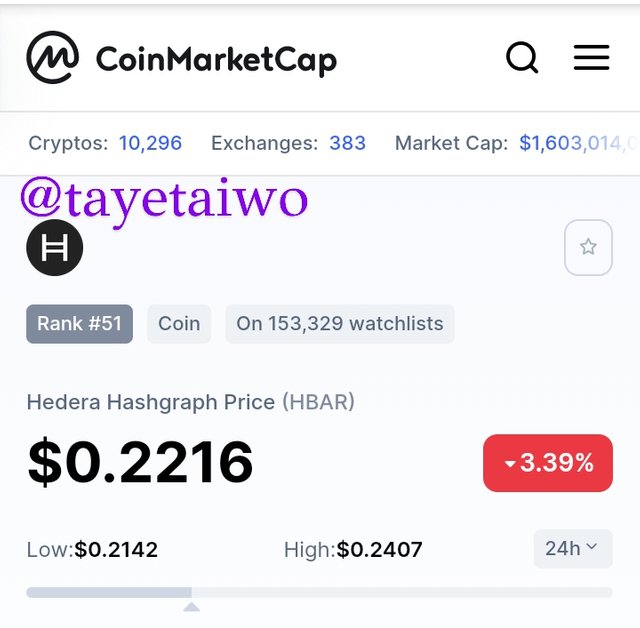
Hedera Hashgraph's native token is HBAR, it is currently trading at $0.2227, ranked #51 with a market capitalization of $1,910,358,425. Currently trading at $225,817,811 in the last 24hrs, HBAR circulating supply is 8.58B HBAR, and a total maximum supply is 50,000,000,000 HBAR.
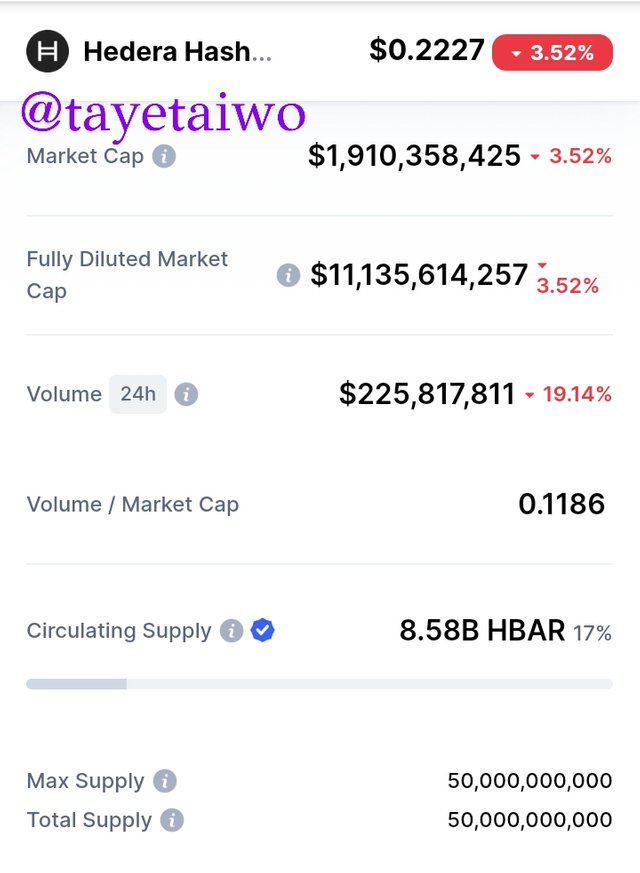
- I visit the official Hedera from my phone browser.
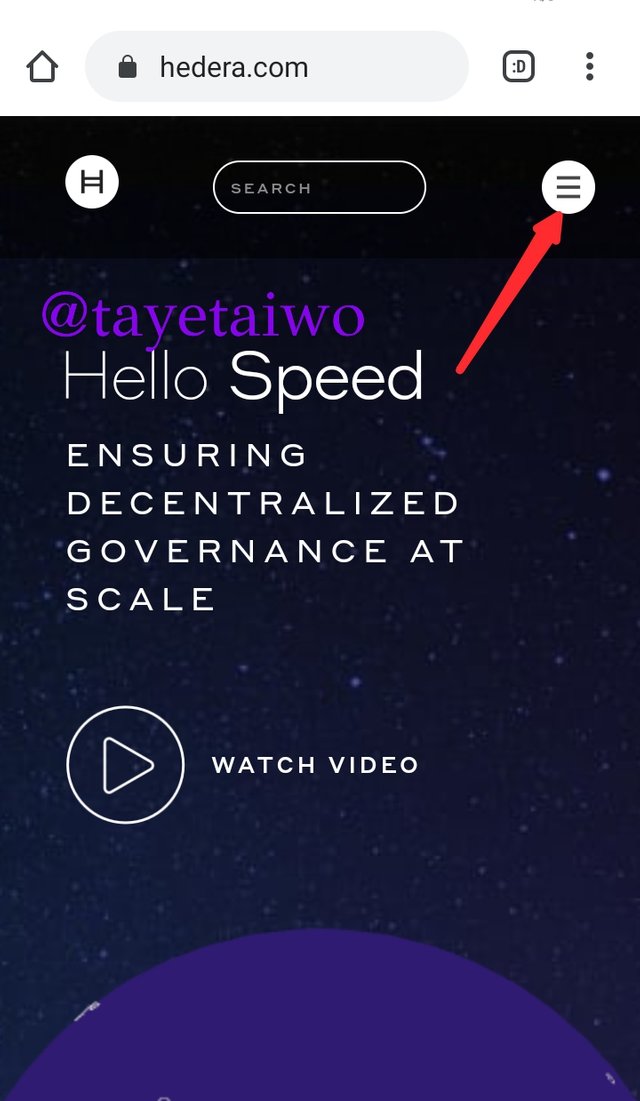
- I Click on the three horizontal lines at the upper side of the page. And this options will be displayed;
Network, Dev, Use Cases, HBAR, Governance and About
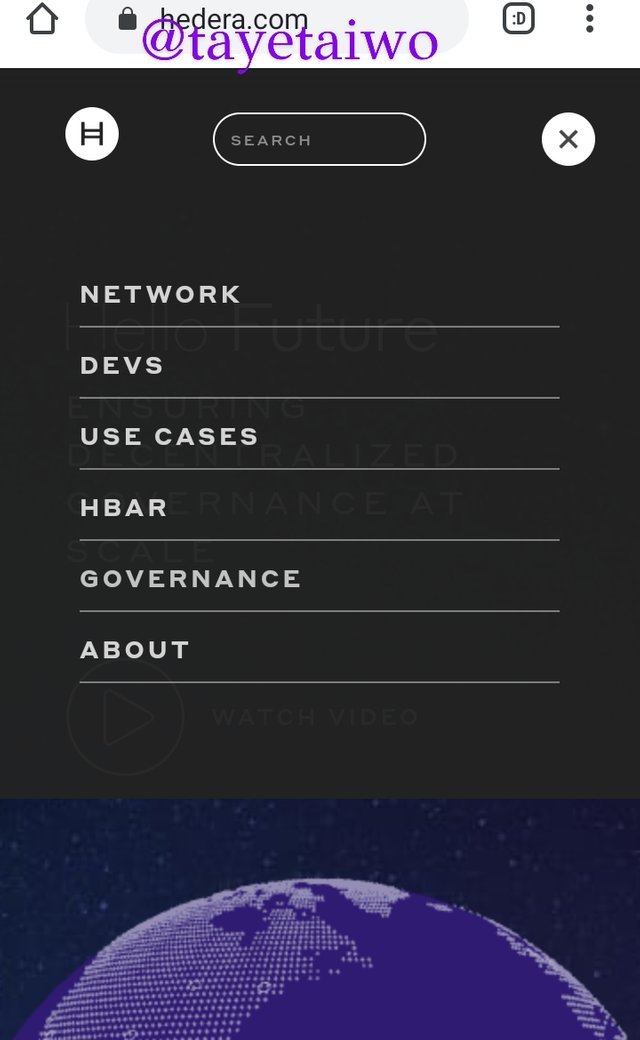
NETWORK
This section consist of Token service options which allow user to generate their own fungible and non-fungible tokens in the native Hedera network without implementing smart contracts. There is another option called Consensus Service, Developers can use the Hedera Consensus Service API to verify the timestamping and ordering of any event for use in any permissioned blockchain or application.
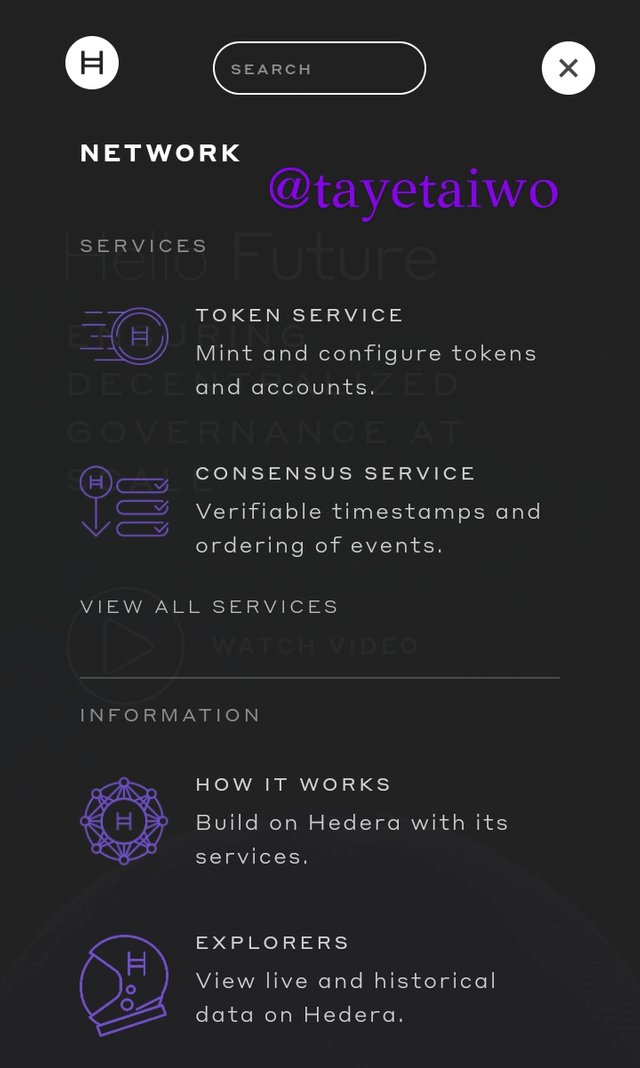
DEVS
The DEVS consist of many options which include;
Tools: this also has sub options;
DOC- this contain all the detailed information about Hedera Hashgraph
Hedera SDK- this offer to teach Hedera API
in numerous languages.
Resources
Integration- Users can link their existing application or permissioned blockchain framework into the Hedera network in this way.
Fees- FEES- displays the fee schedules as set by the governing council; this may be beneficial for developers who wish to know how much it costs to join the Hedera network.
Open source- displayed the codes on the network, as well as the network's updates. To view all updates, you will be linked to the Github site.
Learning center- user can view the institutions and organizations Hedera cooperate with.
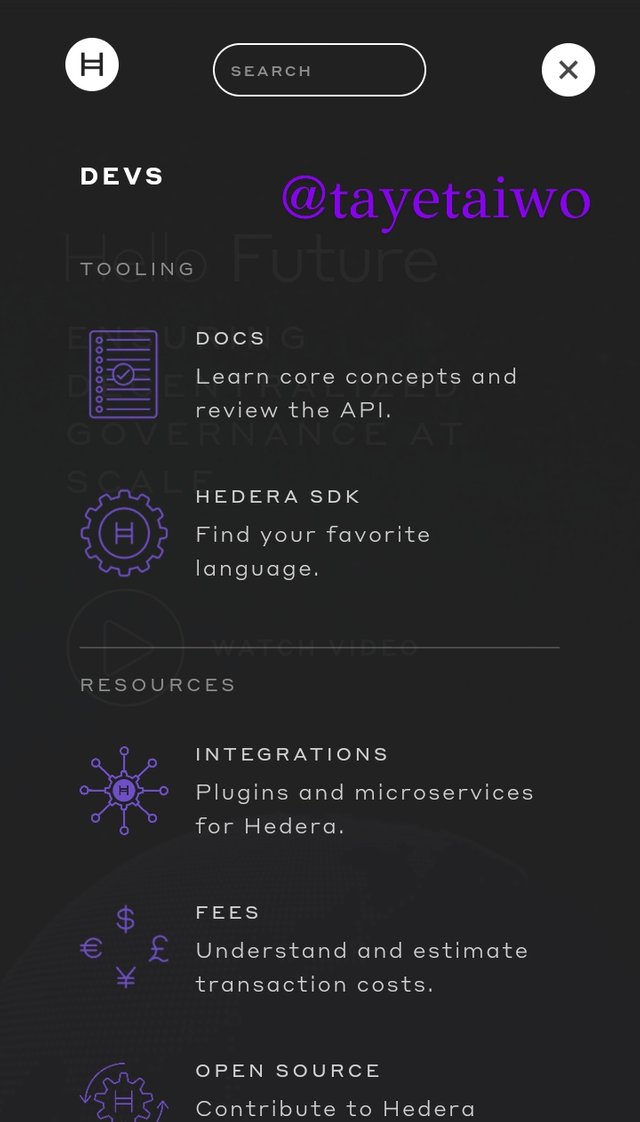
USE CASE
Payment, tokenized assets, fraud mitigation, identity, data compliance, and permissioned blockchain- which allows users to establish private ledgers with public trust- are just a few of the possibilities available in this section.
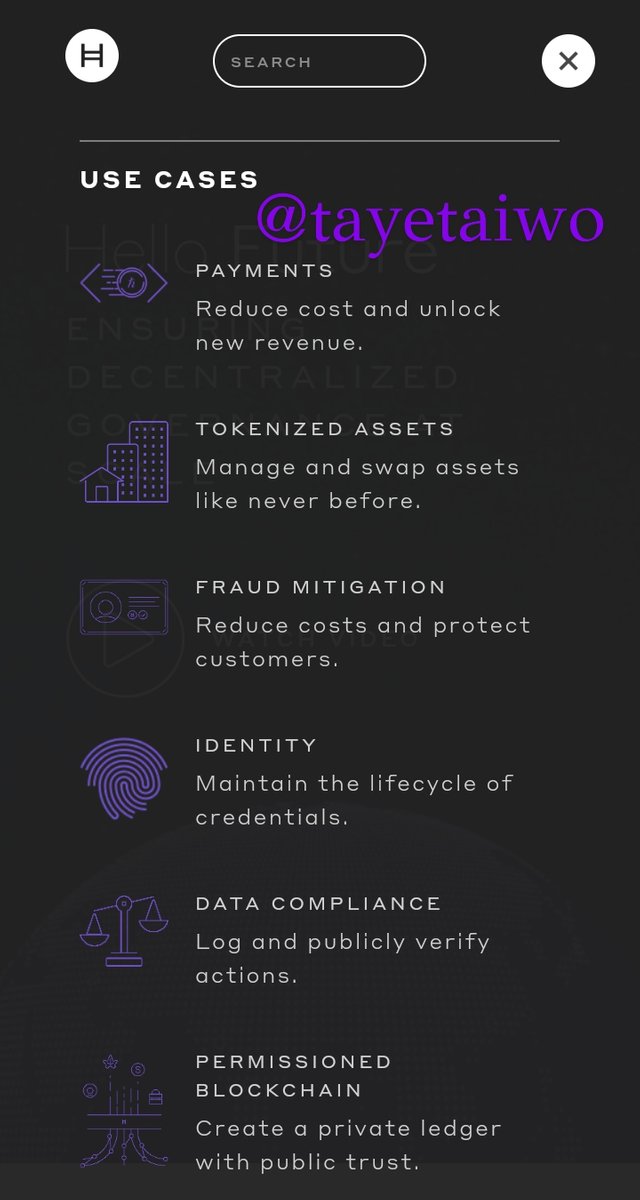
HBAR
This is the section of the Hedera Hashgraph native token HBAR, this consist of many options which include;
Overview- this gives the details of the HBAR cryptocurrency
Account Creation- this allow user to create a Hedera mainnet account with a 3rd party wallet.
- Wallets & Exchanges- this options displayed all the wallet and Exchanges that support HBAR token.
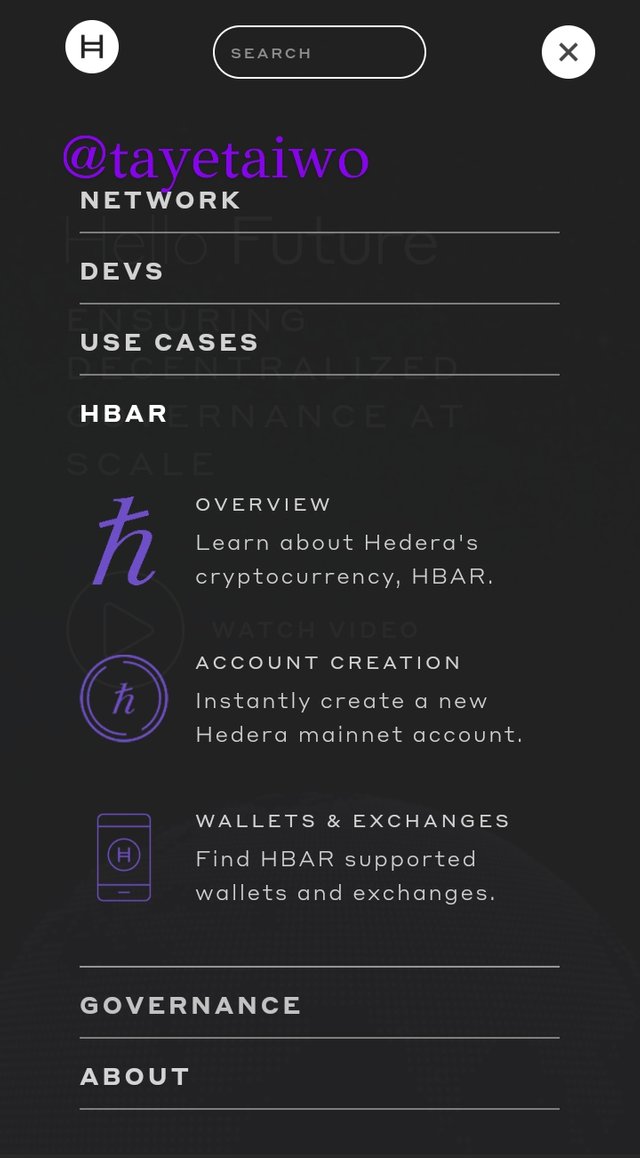
GOVERNING COUNCIL
This section contains information about Hedera Hashgraph's governing council, which, according to the website, consists of 39 term-limited members who represent various organizations and other businesses to form 11 sectors with other non-profit organizations throughout the world. The Hedera Hashgraph governing council's job is to make decisions on a regular basis to maintain the network's stability and to make adjustments as needed to strengthen the network.

ABOUT
This section include some options like Team, Journey, Roadmap, User Group, Careers, Media, Press, News, Blog, and Papers on Hedera Hashgraph Each of the aforementioned links provides the information that a user is seeking for in terms of the link title.

Hedera Team
Check at the team pictures, it on there official website page




Conclusion
In Conclusion Hashgraph is without a doubt a fantastic addition to the crypto world, as it aims to address a few flaws in existing blockchains and has been demonstrated to be faster, safer, and more secure than blockchain. During my research on Hedera Hashgraph, I discovered that an existing permissioned blockchain may be merged into Hedera Hashgraph, which is currently the only permitted Hashgraph technology.
I will like to thank Professor
@pelon53 for this wonderful lecture.
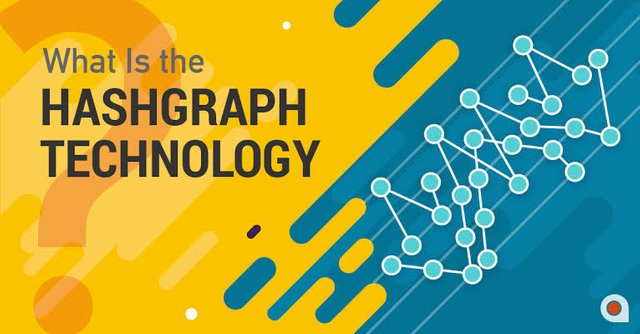
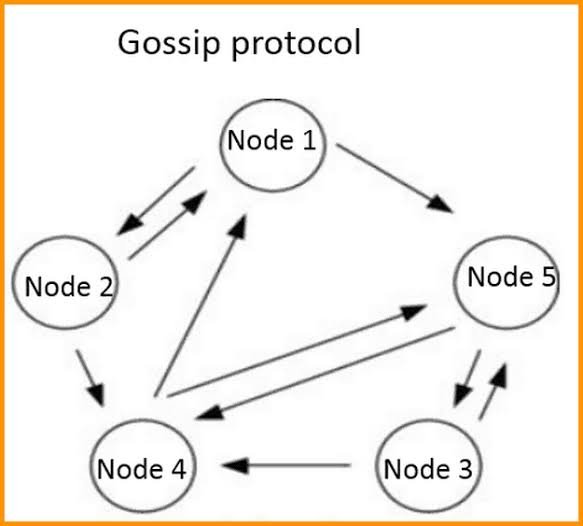
Gracias por participar en Steemit Crypto Academy:
Buen trabajo.
Espero seguir leyendo tus publicaciones.
Calificación: 9.1
Downvoting a post can decrease pending rewards and make it less visible. Common reasons:
Submit